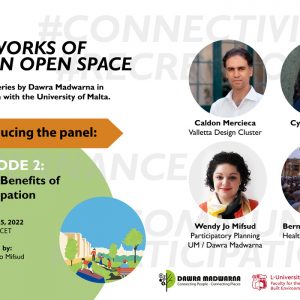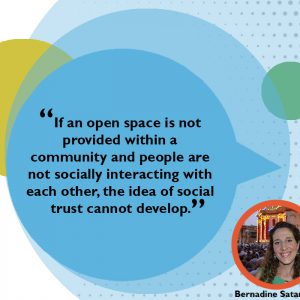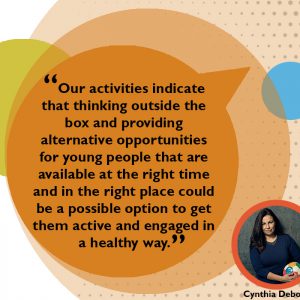Activities
Networks of Green Open Space – Webinar Episode #2
The second webinar of the series Networks of Green Open Space was held on the 25th January 2022. Moderated by Dr Wendy Jo Mifsud and Dr Sarah Scheiber, the webinar featured three panellists, namely Cynthia Debono from MOVE, Caldon Mercieca from the Valletta Design Cluster and Dr Bernardine Satariano from the UM Junior College. Since all these participants prioritise the study of social interactions in the projects they undertake, much was said about how Networks of Green Open Space can be better-designed when they benefit from a bottom-up approach to their development.
Biophilia, defined as the innate human instinct to connect with others and with nature, was a central concept throughout the debate. When speaking of personal experiences and research-based observations, the panellists agreed with other participants that the crux of the issue is the attractiveness of the environment. Once a high-quality environment is available, biophilia can be satisfied by enabling people to enjoy this environment while building strong social relationships through their interaction with each other in public space. Bernardine initiated the debate by stating that whether walking, playing or simply running daily errands, people must start considering green spaces as a resource which can be serendipitously appropriated.
To achieve this, green open space must be responsive to the needs of its users, both current and potential. Quoting Cynthia, responsiveness is hindered when such spaces are “designed for the people but not with the people”, and indeed responsiveness declines as a result of the design process dismissing the importance of the users of the space. As coordinator of MOVE and organiser of the ‘Cycle for Trees’ initiative, she is aware that it is essential for the entire hierarchy of built environment professionals to be accepting of other stakeholder’s views, and that users are included at a time when they have yet the opportunity to change the course of the design process for green open spaces.
Inclusion is therefore about relevancy, as Caldon, who was intimately involved in the design of the Valletta Design Cluster, knows well. Several participants joined the discussion and corroborated that spaces are most successful when they are physically and socio-economically accessible, when people are made to feel welcome to use them, and when they are safe once within them. This also means that green open spaces must be within walking distance of people’s homes, and that threats such as from vehicles are designed out of the route to such spaces. A focus on the micro-neighbourhood can help in the design of green open spaces and dispel the myth that there is “no space for open space”, as Steve, one of our participants, so aptly put it.
Environments that are supportive of active lifestyles are a lynchpin to achieve social justice through networks of green open space. The creation of a series of small spaces to form a ‘green loop’ is in fact one of the central concepts outlined in Dawra Madwarna’s Position Paper on Networks of Green Open Space. Being able to walk to such spaces and enjoy them unrestricted is vital to our wellbeing and to maintaining active and healthy lifestyles from childhood through to old age. Spatial planning policy can respond to this by being designed in a way that incorporates participatory and educational campaigns aimed at increasing public demand for such spaces. Is co-governance therefore the key to this conundrum? We shall see!
To watch the full episode visit the Dawra Madwarna Youtube channel.




